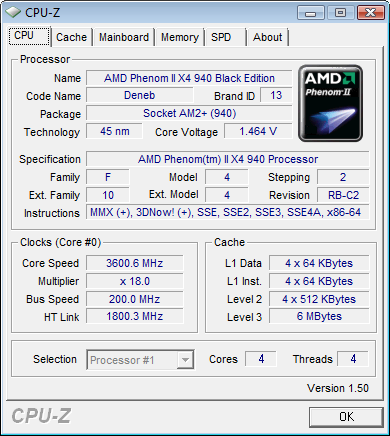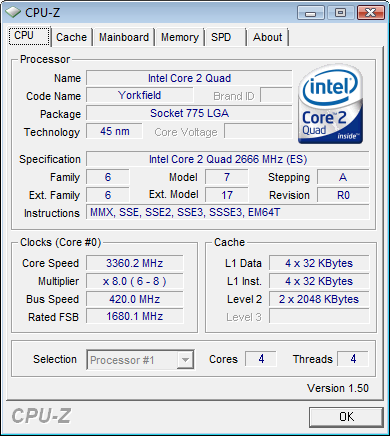The Core 2 Quad Q8400: Intel's $183 Phenom II 940 Competitor
by Anand Lal Shimpi on May 7, 2009 12:00 AM EST- Posted in
- CPUs
Overclocking with a 10% Increase in Core Voltage
While there's something nice about not having to do anything to overclock your CPU other than adjusting a single parameter, tweaking your core voltage has the potential to significantly increase your overclocking potential.
Let's start with the Phenom II X4 940. Using the stock AMD cooler and pushing a max 10% increase in core voltage we ended up with 3.6GHz and a 2.2GHz NB frequency at 1.475V:

I was able to get the chip up to 3.9GHz but not stable enough to complete all of my tests over a significant period of time. Still, a 20% overclock with a moderate increase in core voltage isn't bad at all.
The Core 2 Quad Q8400 saw a 15% increase in clock speed without touching the core voltage. Bumping the core voltage up to 1.45V bought us another 11% taking the chip up to 3.36GHz:

At 3.6GHz vs. 3.36GHz, AMD's clock speed advantage grows to ~7%. Not as big as the 12.7% clock speed advantage at stock frequencies but bigger than the 4% difference in our stock voltage OC attempt.
| Processor | Adobe Photoshop CS4 | x264 HD - 2nd pass | POV-Ray | Far Cry 2 | Idle Power | Load Power |
| AMD Phenom II X4 940 @ 3.6GHz | 20.3s | 21.3 fps | 2839 | 51.5 fps | 120.8W | 256W |
| Intel Core 2 Quad Q8400 @ 3.36GHz | 18.0s | 22.3 fps | 2771 | 59.5 fps | 139.9W | 213W |
At max overclock something interesting happens. Obviously the Q8400 holds on to the lead in Photoshop and Far Cry 2, but POV-Ray goes back to AMD. The x264 encode ends up being a mild victory by the Q8400. Far Cry 2 is bizzare as the Phenom II saw no performance improvement from 3.2GHz up to 3.6GHz, regardless of how many times I ran the test I could never get a higher frame rate out of the system - even with CnQ disabled.There must be some other bottleneck operating here, but it's not a GPU one since the Q8400 was able to scale all the way up to 59.5 fps with the same graphics card.
The situation seems to boil down to this - at max frequency the Phenom II will probably retain its performance lead in 3D rendering and ray-tracing applications, while the video encoding lead goes to Intel. Power consumption also favors the Q8400 significantly.










60 Comments
View All Comments
erple2 - Saturday, May 9, 2009 - link
while there may be fewer defects per wafer, there are also fewer chips per wafer (about 57% fewer). To take the analogy to the extreme, lets say that AMD makes one chip that consumes the entire wafer, and Intel can make 2. If there is, on average, 1 defect per wafer for AMD and 5 defects per wafer for Intel, AMD has zero good chips per wafer, and Intel has (on average), 2 good chips per 5 wafers. That example is horribly contrived, sure, but I used it to show that even having a better process (fewer defects per wafer) doesn't guarantee a good result if the size of the chunks you use on the wafer is significantly larger - AMD's can fit quite a few less per wafer (about half?).erple2 - Saturday, May 9, 2009 - link
arg... edit button... Intel would have 1 good chip per 3 wafers. I assumed 4 defects per wafer, not 5 in the 2/5 ...slayerized - Thursday, May 7, 2009 - link
You are confusing yield and throughput - they are two different things.8steve8 - Thursday, May 7, 2009 - link
no Virtualization Tech... so no windows 7 virtual PC, no hyper-v...that sucks.
rather go phenom 2, intel e8xxx or q9xxx
ltcommanderdata - Friday, May 8, 2009 - link
I don't think the lack of VT will be a huge issue for the average consumer. The Q8400 is a budget quad core and OEMs will no doubt be bundling Windows 7 Home Premium with it which doesn't support XP Mode anyways. Tech savy buyers who build their own computers with a Q8400 and Professional Edition would notice, but the larger impediment to XP Mode adoption is probably still Microsoft's production edition matrix.Anand Lal Shimpi - Thursday, May 7, 2009 - link
Very good point, I've updated the conclusion to point out the difference. Honestly it's ridiculous that Intel isn't enabling it on these chips.Take care,
Anand
spazmedia - Thursday, May 7, 2009 - link
I second this. Just bought a intel box with an E5200 thinking it had VT. Hopefully they will follow AMD's lead.GeorgeH - Thursday, May 7, 2009 - link
+1No support for Windows 7 XP Mode is the reason I chose AMD over an Intel Q8X00 in the PC I just built.
leomax999 - Thursday, May 7, 2009 - link
Intel has announced vt support for Q8300, E7400, E7500, E5300, E5400.So i dont see any reason why q8400 shouldnt get it.
http://www.tcmagazine.com/comments.php?shownews=25...">http://www.tcmagazine.com/comments.php?shownews=25...
GeorgeH - Thursday, May 7, 2009 - link
Thanks for the link, but to be clear the chips you listed will never support VT.Intel is supposed to be releasing Q8300".1", E7400".1", etc. chips, but unless they change the model number I can only see that leading to mass confusion. Forcing average people to check the S-Spec or MM number against a list to see what they're actually getting is a classic recipe for fail.
Until those updated Intel chips hit the market, AMD will remain the only real choice for budget and midrange quad core.